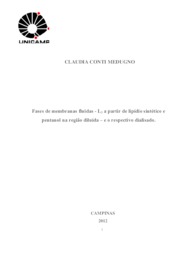Fases de membranas fluidas -L3 a partir de lipídio sintético e pentanol na região diluída - e o respectivo dialisado
Fases de membranas fluidas -L3 a partir de lipídio sintético e pentanol na região diluída - e o respectivo dialisado
Autoria: MEDUGNO, C. C.
Resumo: Abstract: The amphiphilic L3 (sponge) phase was observed in the late 80's and represents a new class of self-assembly for surfactant-water systems. This work describes the discovery and subsequent characterization of a ternary phase composed of synthetic cationic lipid dioctadecildimetil ammonium bromide (DODAB), pentanol and water in a diluted region. This is the first description of a L3 phase prepared from a lipid with a relatively small polar head and two hydrocarbon chains with 18 carbons each one. The region of the triangle diagram in which there is L3 phase was characterized using optical isotropy and anisotropy to a probe with electron paramagnetic resonance spectroscopy technique. The proposal of an L3 phase was made by comparison with a similar system reported by the group of Montpellier. The description accepted is that in a narrow close ratio of surfactant/cosolvent concentrations, membrane fusion occurs with the formation of a highly interconnected and randomly distributed network of bilayers in space. The assumption of formation of the L3 phase is that the hydroxyl group of pentanol pairs with the lipid heads and this fact is able to change the bilayer curvature. The various DODAB/pentanol preparations remained unchanged and stable for five years only up to the concentration of 3 mM of lipid, the maximum concentration that can be called L3 phase, which is thermodynamically stable. To make the system more attractive for many potential uses it was necessary to increase the weight of the lipid. Concentrations up to 10 millimolar, after a few hours, break down into tiny droplets and small crystals, so-called multiphase. The next step was to completely remove the alcohol by continuous dialysis. The result was the appearance of a phase similar to water, which cannot be obtained otherwise. A sequence of spectroscopic and chromatography measurements showed that the alcohol was entirely eliminated by dialysis as the lipid was retained. There is a notable change when compared with other DODAB/water binary preparations. In the same concentration, all of them have pronounced turbidity. The hypothesis is that the presence of alcohol in the bilayer promotes reorganization, transforming a particulate into a bicontinuum system. Efforts to characterize these systems are justified because they are easy to prepare and have potential uses in the synthesis of inorganic solid new materials with nanostructured pores, and as drug carriers and vehicles for the crystallization of proteins.
Ano de publicação: 2012
Tipo de publicação: Teses
Unidade: Embrapa Meio Ambiente
Palavras-chave: Membrana, Membranas líquidas, Physical-chemistry, liquid membranes
Observações
1 - Por padrão são exibidas publicações dos últimos 20 anos. Para encontrar publicações mais antigas, configure o filtro ano de publicação, colocando o ano a partir do qual você deseja encontrar publicações. O filtro está na coluna da esquerda na busca acima.
2 - Para ler algumas publicações da Embrapa (apenas as que estão em formato ePub), é necessário ter, no celular ou computador, um desses softwares gratuitos. Sistemas Android: Google Play Livros; IOS: iBooks; Windows e Linux: software Calibre.
Acesse outras publicações
Acesse a Base de Dados da Pesquisa Agropecuária (BDPA) para consultar o acervo completo das bibliotecas da Embrapa.

